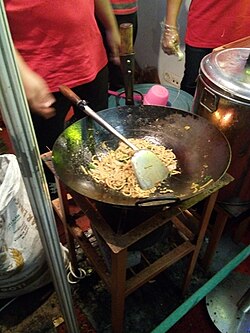 Mie goreng in a restaurant in Jakarta | |
| Alternative names | Bakmi goreng, Mi goreng |
|---|---|
| Type | Noodle |
| Course | Main course |
| Place of origin | Indonesia [1] |
| Region or state | Nationwide |
| Serving temperature | Hot |
| Main ingredients | Fried noodles with chicken, meat or prawn |
Mie goreng (Indonesian : mi goreng; meaning "fried noodles" [2] ), also known as bakmi goreng, [3] is an Indonesian stir-fried noodle dish. It is made with thin yellow noodles stir-fried in cooking oil with garlic, onion or shallots, fried prawn, chicken, beef, or sliced bakso (meatballs), chili, Chinese cabbage, cabbages, tomatoes, egg, and other vegetables. Ubiquitous in Indonesia, it is sold by food vendors from street hawkers ( warungs ) to high-end restaurants.










